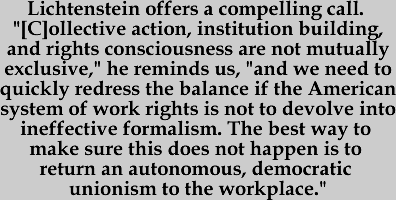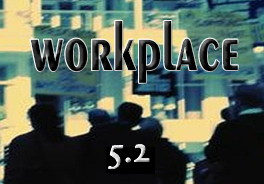![]()
State of the
Union: A Century of American Labor
by Nelson Lichtenstein
Princeton UP, 2002
Michael Bersin
1.
I am a person.
2.
With 21st-century sensibilities and deference to the 1968 Memphis sanitation
strikers, this immutable fact of any individual’s value will never change,
and thus the need to organize workers will continue.
 3.
A union by definition and in practical reality is a democratic enterprise.
Any corporation, or for that
matter, any institution that hires
labor, is not. For a variety of reasons, including monetary and political
clout, corporate entities continue to market a social and moral equivalence,
if not superiority, to organized labor. All this aided by the “fact” of
corporate personhood.
3.
A union by definition and in practical reality is a democratic enterprise.
Any corporation, or for that
matter, any institution that hires
labor, is not. For a variety of reasons, including monetary and political
clout, corporate entities continue to market a social and moral equivalence,
if not superiority, to organized labor. All this aided by the “fact” of
corporate personhood.
4.
Richard Behan reports on the myth that corporate personhood was supposedly
established by an 1886 U.S. Supreme Court ruling in Santa Clara v.
the Southern Pacific Railroad. Behan points out that the casebook
"headnote" (which has no legal weight, nor can it establish
precedent) contains the only mention of corporations as persons and was
written as a summary by a court reporter with some level of allegiance
to the railroad industry.
5.
The implication for organized labor and others: ultimately, the advantage
gained in those asserted "personal" rights of corporations is
based on a falsehood.
6.
Witness the simplistic discussion over aspects of campaign finance reform.
A democratic union and an oligarchic corporation —the stockholders do
not achieve their status via democratic means - are given equivalence
in the rhetoric over limiting campaign contributions. The fatal political
flaw, at least for the corporations, is that individual union members
can vote. The almost insurmountable barrier for unions is that corporate
money buys access and ultimately becomes the tipping point under this
illusion of equivalence.
7. Nelson
Lichtenstein's State of the Union: A Century of American Labor
offers an informative historical and philosophical summation — a true
history of labor as it were, which provides the reader with the intellectual
capital to wade through the "labor question." He devotes his
chapters to a chronological story, an interweaving through the 20th century,
of the various union movements’ sometimes competing interests and the
determined and almost monolithic anti-union theology of various individuals,
corporations, and interest groups. All this interspersed with the
on again, off again support or hostility of the governments in power.
8.
Lichtenstein offers a compelling call. "[C]ollective action, institution
building, and rights consciousness are not mutually exclusive," he reminds
us, "and we need to quickly redress the balance if the American system
of work rights is not to devolve into ineffective formalism. The best
way to make sure this does not happen is to return an autonomous, democratic
unionism to the workplace" (211).
9.
In the conflict between capital and labor it is perhaps ironic that one
of the few instances where capital takes a long view is in their ongoing
goal to manipulate and ultimately eliminate organized labor, and with
it, workers’ democratic self-representation. As evidence Lichtenstein
cites the cynical exploitation of cultural politics, the "dirty science"
of anti-union paternalism, and "management by stress" (242,
244).
10.
In his discussion of the principles of labor-management relations, Lichtenstein
also describes the long case history of RCA— from 1930’s New Jersey, to
Indiana, to 1960’s Memphis, to the present day maquiladoras in Ciudad
Juarez— and its "spatial fix” capital flight in search of pliable non-union
workers. This flight "has certainly destroyed jobs and communities
in the United States, but without offering capital the decisive managerial
victory for which it continually struggles" (224). Is this then the ultimate
outcome of placing short term profitability over the greater good of society?
The futility of such, as workers seek to organize in each locale— and
were it not for the real human costs—could be almost construed as comic.
Lichtenstein points out, illuminating with the vivid verbal image of a
defiant union organizer, that in Ciudad Juarez "the proletarianization
experience once again transformed docile girls into rebellious women"
(225). The hope is in the journey.
11.
Further, Lichtenstein offers three strategic propositions to rebuild organized
labor for the future: militancy (to which I would add solidarity and education),
internal union democracy, and politics.
12.
Through education and solidarity we can ensure that labor’s militancy
in defense of its prerogatives can help insulate labor from the public
relations scams promulgated by a corporate controlled media, a hostile
corporate world, or an indifferent, if not hostile, government.
13.
Internal union democracy is, as Lichtenstein points out, absolutely essential.
The worth of that democracy to any individual worker must be direct and
palpable. As with any political process it will take determined individuals,
 grassroots
organizing, and yes, the return to the shop steward halting production
with a single whistle blast.
grassroots
organizing, and yes, the return to the shop steward halting production
with a single whistle blast.
14. Lichtenstein
explains that the lack of a labor-based political party in America (as
opposed to much of the industrial West) is a function of the inherent
limitations in our "winner-take-all system" of electoral federalism.
"Given the decay into which America’s contemporary political-party
system has fallen," he concludes, "labor must function as an
independent, and sometimes as a disloyal, component of the Democratic
Party coalition" (276). I have news for Nelson Lichtenstein: it already
does.
15.
But, to posit a clean break between organized labor and the Democratic
Party one must first examine and understand the membership, activist infiltration,
and cross fertilization of labor within both of the major political parties.
Realizing the political and practical realities, one then understands
why, with the significant help of organized labor, Democrat Al Gore won
the 2000 presidential election by 543,895 votes (Federal Election Commission)—even
while being out raised by his opponent $185,921,855 to $120,031,205 (Open
Secrets).
16. The
inescapable conclusion one can derive from Lichtenstein’s final proposition:
unless and until organized labor achieves its full potential, it will
continue to suffer at the hands of those who profit from the manipulation
of electoral federalism.
17.
If labor is successful, then future workers will not have to carry a picket
sign with the 21st century equivalent to 1968’s "I am a man."
Works Cited
Behan, Richard W. (December 26, 2002)
"Sing, Dance, Rejoice—Corporate Personhood Is Doomed: A Review of
Thom Hartmann's Unequal Protection: the Rise of Corporate Dominance
and the Theft of Human Rights." CommonDreams. http://www.commondreams.org/views02/1226-04.htm
Cowie, Jefferson (1999). Capital
Moves: RCA’s Seventy-Year Quest for Cheap Labor. Ithaca, NY: Cornell
University Press.
http://www.fec.gov/pubrec/fe2000/prespop.htm
http://www.opensecrets.org/2000elect/index/AllCands.htm
